Adam Yamey's Blog: YAMEY, page 74
October 8, 2023
Indian influences in a house on the Isle of Wight
YESTERDAY (THE 4th OF OCTOBER 2023), I gave a short talk to introduce my book about the pioneering Victorian photographer Julia Margaret Cameron (1815-1879). Born in Calcutta (Kolkata), she died in Ceylon (Sri Lanka). Between 1860 and 1875, Julia and her family lived at Freshwater Bay (on the Isle of Wight) in a house called Dimbola. It was named after one of Mr Cameron’s coffee plantations (Dimbula) in Ceylon. The house at Freshwater Bay is now a well-curated museum dedicated to Julia and her photographic works. It was in its large tearoom, once the Cameron’s dining room, that I gave my brief talk.
When the Cameron’s bought Dimbola (at Freshwater), which is close to the house where the poet Alfred Lord Tennyson lived, it was a group of two separate cottages. Builders were employed to join the two buildings to create one large residence. A crenelated tower was constructed to join the two formerly separated edifices. From the outside Dimbola appears to be a typical Victorian construction. However, inside a treat awaits the visitor.
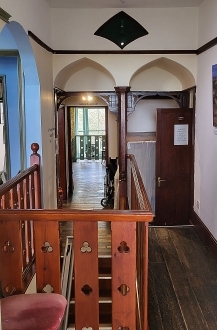
Apart from the interesting exhibits in the museum, some of the house’s internal decorative features deserve attention. There is much timberwork that reminds one of India. The Cameron’s designed parts of their house in what is often known as the ‘Indo-Saracenic’ style. This is an often-successful marriage of gothic and Islamic architectural details. Wikipedia expands on this as follows:
“Indo-Saracenic architecture (also known as Indo-Gothic, Mughal-Gothic, Neo-Mughal, in the 19th century often Hindoo style) was a revivalist architectural style mostly used by British architects in India in the later 19th century, especially in public and government buildings in the British Raj, and the palaces of rulers of the princely states. It drew stylistic and decorative elements from native Indo-Islamic architecture, especially Mughal architecture, which the British regarded as the classic Indian style, and, less often, from Hindu temple architecture.”
Apart from the magnificent example of this decorative style in the Durbar Room at Osborne House (on the Isle of Wight), there are few if any examples of its usage in houses in England that can rival that which can be seen at Dimbola. Fortunately, Dimbola was saved from demolition late in the last century. Had it been demolished to make room for holiday flats, this superb example of the use of Indo-Saracenic style, which harmonises well with some of Dimbola’s Arts and Craft style details, would have been lost. During recent restoration of the house, the walls have been covered with reproductions of the Arts and Craft Style wall papers that used to decorate the place back in the 19th century. Some fragments of the original William Morris wallpapers were discovered during the restoration works. In addition, a wall with Victorian paintwork was found, and has been preserved, albeit a little faded, in its original state.
A visit to Freshwater’s Dimbola is worthwhile, not only to imbibe the atmosphere of the home of the charismatic Victorian photographer but also to enjoy excellent coffee and home-made cakes in its delightful café. And while you are there, you can buy a copy of my book “BETWEEN TWO ISLANDS: JULIA MARGARET CAMERON AND HER CIRCLE” in the museum’s small shop. If you are unable to reach Dimbola, you can get a copy from Amazon sites such as:https://www.amazon.co.uk/dp/B0BZFCVLX9/
October 7, 2023
A socialist and a vegetarian by the seashore on the Isle of Wight
A DISTINCTIVE BUILDING stands opposite the Art Deco Winter Garden (built by 1936) high above the seashore of Ventnor on the south side of the Isle of Wight. With a tower overlooking the sea, the edifice facing the Art Deco structure was which was built in 1846 by the Reverend Richard John Shutte (1800-1860), who had once been a canon at St Paul’s Cathedral. It was named St Augustine Villa (see photograph below), and now houses a hotel and restaurant.
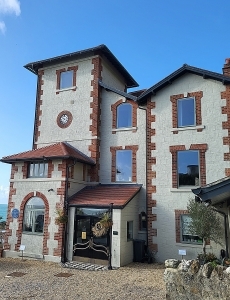
Several Russians opposed to the Imperial Romanov regime, including the writer Ivan Turgenev(1818-1883) visited Ventnor during the 19th century. Amongst these was Alexander Herzen (1812-1870), who was the ‘father’ of Russian Socialism’. In 1852, he and his family began living in England for several years. During this sojourn, he made some visits to the Isle of Wight. In September 1855, Herzen stayed in Augustine Villa, which he had rented. However, he was not alone as the commemorative plaque on the Villa notes. He stayed there with Malwida von Meysenbug (1816-1903).
Now, I had already heard of Herzen. I became familiar with his name when watching a trilogy of plays by Tom Stoppard about 19th century Russian Socialism. However, I had never come across Malwida von Meysenbug until I saw that plaque in Ventnor. A writer, she was born in Kassel (Germany) and was a friend of both Friedrich Nietzsche and Richard Wagner. By the time that Herzen and Malwida had their holiday in Augustine Villa, she was living with Herzen’s family and helping to look after his children. Alexander’s wife Natalia had died in 1852, and he had hired Malwida to educate his children.
Malwida was much more than a mere governess as the UCL academic Sarah J Young explained in her excellent, highly informative article (http://sarahjyoung.com/site/2011/11/10/in-herzens-footsteps-a-visit-to-ventnor/). In this essay, Dr Young gives excerpts from Malwida’s published “Memoirs”. The following is particularly interesting:
“We spent happy days in beautiful Ventnor. In the evenings we were usually with the Pulszkys, who were spending the summer there. Therese’s mother, an educated and intelligent Viennese lady, had come to visit them, and this made for many a pleasant hour with her keen humor and wit. The Kossuths were also there, and he was much more pleasant in a more intimate setting than he had been at the formal gatherings in London. At the time, our thoughts were preoccupied by the war Russia had started with Turkey. Herzen, more so than the others, was very excited. He prophesied the Russian defeat and wished for it, since he believed it would lead to the downfall of autocracy.”
The Kossuths, were members of the family of the Hungarian revolutionary Louis Kossuth, whom Herzen was extremely excited to have met during his stay in Ventnor. Another exiled Hungarian revolutionary, Ferenc Pulszky (1814-1897) was also staying with his family in Ventnor at the same time as the Herzens and the Kossuths. Pulsky’s wife, Theresa, and Malwida spent time drawing together in Ventnor, and made several competent sketches of Ventnor and its surroundings,
Dr Young also quoted Herzen, who noted in his diaries that Malwida:
“… spent all her time in the water …”
From what Dr Young and others have discovered during their research, Malwida was out of the sea long enough to create works of art depicting the seaside resort.
Herzen liked Ventnor but had some reservations as he wrote in a letter (quoted from Dr Young’s article):
“For three days the weather has been like June – and I’m bathing recklessly in the sea. But before that there were four days of storms, rain and bitter cold … If it were not so boring, I would live here, but there are no resources at all. And getting to Ryde is expensive … “
Many years have passed since Herzen and Von Meysenbug holidayed in Ventnor. Slightly less time has elapsed since the future Mahatma Gandhi visited Ventnor in 1890 and 1891. According to one source (www.bonchurchvillage.co.uk/post/bonchurch-gandhi), Gandhi:
“… had wanted to study medicine but his father had objected, and his studies were in law. He was a prominent member of the London Vegetarian Society, and that may have led to his staying at Shelton’s Vegetarian Hotel at 25 Madeira Road in Ventnor, in January 1890 and again in May 1891, on the second occasion addressing a Vegetarian meeting in Ventnor.”
In his autobiography, Gandhi wrote of the following experience in Ventnor:
“My cowardice was on a par with my reserve. It was customary in families like the one in which I was staying at Ventnor for the daughter of the landlady to take out guests for a walk. My landlady’s daughter took me one day to the lovely hills round Ventnor. I was no slow walker, but my companion walked even faster, dragging me after her and chattering away all the while. I responded to her chatter sometimes with a whispered ‘yes’ or ‘no’, or at the most ‘yes, how beautiful!’ She was flying like a bird whilst I was wondering when I should get back home. We thus reached the top of a hill. How to get down again was the question. In spite of her high-heeled boots this sprightly young lady of twenty-five darted down the hill like an arrow. I was shamefacedly struggling to get down. She stood at the foot smiling and cheering me and offering to come and drag me. How could I be so chicken hearted? With the greatest difficulty, and crawling at intervals, I somehow managed to scramble to the bottom. She loudly laughed ‘bravo’ and shamed me all the more, as well she might.”
I do not think that Gandhi made any other visits to Ventnor or elsewhere on the Isle of Wight.
Today, Ventnor is still delightful and although much has been modernised since the Victorian era, it still retains an almost unspoilt old-world charm. I fancy that were it possible for Herzen and Malwida and their revolutionary friends to return today, they would find much in Ventnor that they would easily recognise.
Seeing the plaque on Augustine Villa made me curious about Herzen’s stay in Ventnor and the identity of Malwida von Meysenbug. By reading up about it, I learned of other noteworthy visitors to the town, and as I did so my interest in Ventnor has increased considerably.
PS: a list of some more of the famous visitors to Ventnor can be found at /www.ventnortowncouncil.gov.uk/about-ventnor/famous-residents/
October 6, 2023
It’s saucy, but not ketchup or tartare at the Codfather
‘THE CODFATHER’ IS A NAME shared by many fish and chips shops in England. There is one such establishment opposite the railway station at Ryde Esplanade on the Isle of Wight. It is a typical traditional fish and chips place, but with one distinguishing feature.
There is a circular commemorative plaque on its external wall. This was placed to remember when this shop was raided by the police in September 1953. Then, the shop was owned by John Leigh. During the raid, the police confiscated 1087 postcards designed by Donald McGill.
 By Donald McGill
By Donald McGill McGill (1875-1962), a graphic artist, created over 12000 seaside postcards between 1904 and his death. Almost all of them had humorous pictures on them. They were prints made from his colour-washed drawings. Some of them were classed as “saucy”, which means they depicted scenes with typically British sexual innuendo.
In 1954, McGill fell foul of the Obscene Publications Act of 1857, and was found guilty. He was fined £50, and had to pay £25 in legal costs. The 1953 raid on John Leigh’s shop was only one of 5 such raids in Ryde. Mr Leigh was the proprietor of what was then ‘The Esplanade Bazaar’, which sold ‘fancy goods’. It would seem that he also stocked saucy postcards, maybe illicitly.
Today, The Codfather occupies Mr Leigh’s shop. Its polite helpful staff served us fish and chips, but seemed not to know much about the raid on their premises seventy years ago.
October 5, 2023
The village that disappeared from Devon
DURING THE 1890S, construction of new concrete naval structures commenced at Plymouth naval dockyard. The nearest source of gravel suitable for incorporating in concrete was in Start Bay on the south coast of Devon (just west of Dartmouth). Dredgers, which were able to suck up vast amounts of gravel from the seafloor, were sent to Start Bay. Every day, enormous amounts of gravel were removed from the Bay.
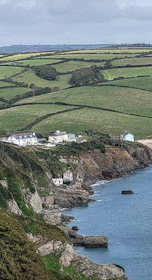 The remains of Hallsands are thr 2 houses closest to the sea
The remains of Hallsands are thr 2 houses closest to the seaThe inhabitants of the tiny fishing village of Hallsands, whose location was between Beesands and Start Point, noticed that as the gravel was being removed, the level of the sea was gradually lowering. This began to become serious because the gravel that was being removed in vast quantities had formerly protected the village (and others nearby) from being washed away by the action of the sea’s waves. When the authorities became aware of the damage being caused, gravel extraction was ended. But this was too late.
A huge storm in 1917 caused most of Hallsands to be washed into the sea, leaving only a couple of houses standing, albeing precariously. Had the gravel not been removed, the damage might have been considerably less, and more of the village might have survived.
Until recently, the precarious remains of Hallsands could be seen from a viewing platform high above the site. However, during the last year or two, further damage has made the path leading to the platform too dangerous to be used, and it has been fenced off.
Neighbouring coastal villages such as Beesands and Tor Cross, have also suffered damage from the sea because of the gravel extraction, but high thick concrete seawalls were constructed and barriers of huge rocks have been placed, and so far the villages’ integrity has been protected.
Old photographs show what Hallsands looked like before it disappeared. They reveal that its buildings resembled those still standing at Beesands. Whereas this village stands on level ground, the buildings in Hallsands used to line a steeply sloping main street that ran downhill to a small fishing harbour.
Although the tragic consequences of gravel extraction were predicted early enough, cessation of the removal of this protective material did not occur until it was far too late to prevent disaster. The villagers who lost their homes and livelihoods had to wait many years before they received any compensation.
Start Bay is a beautiful place to visit. Had our friends Tim and Christine not taken us there, it is quite possible that we would not have become aware of its tragic recent history.
October 4, 2023
Double-headed eagle in Dartmouth
THE NATIONAL SYMBOL of Russia, both before and after the Communist era, is a bird with two heads, two necks, and a single body – the double-headed eagle (‘DHE’). I have long been interested in this imagined creature because it appears on the flag of Albania, a place that has interested me for many years.
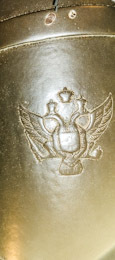
While walking along the riverfront in Dartmouth (Devon), our friend pointed out a historic cannon positioned with its barrel pointing towards the water. On the top of the barrel there is a small bas-relief depicting a DHE.
The cannon was manufactured in the Russian city of Briansk in 1826. It was captured from the Russians in the Crimean War (1854-1856) and is one of several Russian cannons brought to England after or during that conflict.
We have visited Dartmouth many times before, but barely noticed the old cannon. Had our friend not told us of the origin of that cannon, one of many disused artillery pieces that can be found serving as ornaments all over England, I would have been unaware of this example of a double-headed eagle in Dartmouth.
October 3, 2023
Footsteps of the famous in Falmouth and Sarajevo
IN THE 1980s when Yugoslavia existed, I used to visit the Bosnian city of Sarajevo regularly. In the centre of the town there was (and might still be) a museum about the assassination of Archduke Franz Ferdinand in 1914. Near this, there were impressions of two footprints in the pavement. These mark the supposed spot from which Gavrilo Princip fired the shots that killed the Archduke. You could stand in that very spot if you wished. I have no idea whether this curious memorial still exists but I was reminded of it when walking along the waterfront in Cornwall’s Falmouth.
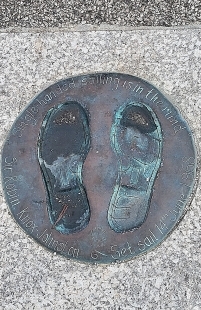
On the 14th of June 1968, Sir Robin Knox-Johnson (born in 1939) set sail from Falmouth as a competitor in the Sunday Times Golden Globe race. In his small boat, the 32-foot Suhaili (a Bermudan ketch), he circumnavigated the World non-stop. Having won the race, he disembarked at Falmouth on the 22nd of April 1969.
Just as Princip’s exploit was commemorated by imprints of footprints, so was Sir Robin’s. However, at Falmouth there are two sets of footprints embedded in brass plates. One set has its toes pointing towards the sea, and the other, commemorating Sir Robin’s return, has its toes pointing towards the land (away from the sea).
Whereas the impressions of Princip’s footsteps make us remember the terrible consequences of his actions, those of Sir Robin celebrate a great achievement.
October 2, 2023
Fish as fresh as fresh can get
OUR FRIENDS ELAINE and Kim spent a few days in the Cornish port of Looe. When we met them after their stay, they told us about the wonderful fish they bought in the town, and cooked in their accommodation. As we love seafood and had never been to Looe on any of our many visits to Cornwall, we decided to visit the town with the aim of buying fish there.
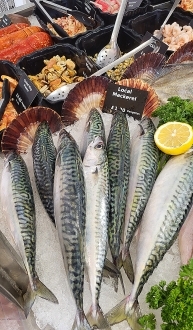
A man working in the crowded car park close to the bridge with many arches that crosses the River Looe, which runs through Looe, suggested we visit a fishmonger called Pengellys. And what a splendid suggestion that was. The shop is small but filled with a wonderful display of fresh fish and other seafood.
Pengellys was established in 1946. The friendly man, who served us, explained that because the firm was started so long ago, all of the seafood (except the salmon) sold in the shop is only a few hours old. Pengellys are able to buy their seafood directly from the fishing boats that dock in Looe. Other fishmongers, which were established more recently, are unable to do this – they have to buy their stock from wholesalers in Newlyn and/or Plymouth. Therefore, the seafood sold by Pengellys has spent less time travelling between ship and shop than that sold at other fishmongers. He told us that the mackerel fillets, which we purchased, had been caught less than two hours before we entered the shop. He explained that one could tell how fresh they were by the green sheen on the skin. This tends to fade the greater the time since the fish was caught. We purchased mackerel and plaice fillets, as well as scallops and samphire. Each of these items were as fresh as fresh can be, and were delicious when fried briefly in butter. Pengellys have certainly caught us as customers – hook, line, and sinker.
October 1, 2023
A much used word in Cornwall
FEW, IF ANY people in Cornwall are fluent speakers of the Cornish language. However, one word of this language is still in common usage. That word is ‘dreckly’. When I first noticed it outside a shop we drove past, I imagine the word meant ‘directly’.

Today, we were sitting in Dollies on Molesworth Street in Wadebridge – one of our favourite cafés in Cornwall – when I spotted a notice which read:
“All meals prepared fresh to order – dinner comes dreckly…”
I asked the owner’s son, who works in the place, about the meaning of ‘dreckly’. He told me that it is a very useful word, which means roughly ‘in the future’. If something or somebody is coming dreckly, that can mean its arrival might be in a few minutes, or a few hours, or a few days, or maybe never at all.
As I am always keen on checking information I have gathered, I looked up ‘dreckly’ on the Internet, and discovered that my informant had been quite accurate. According to urbandictionary.com:
“Dreckly is something that you will get around to at some point in the future, possibly never.”
And another source (Wikipedia) confirms this:
“Dreckley / Dreckly – at some point in the future; soon, but not immediately; like ‘mañana’, but less urgent.”
So, now I am satisfied about the meaning and usage of the word.
I will endeavour to learn some more words of Cornish … dreckly!
September 30, 2023
A rook with a book in a Cornish town
THE AUTHOR DAPHNE du Maurier (1907-1989) was born near London’s Regents Park, but spent much of her childhood in Hampstead. In the summer, she travelled with her family for holidays in Cornwall. They also lived there during WW1. In 1926, the family bought the still extant Ferryside, a house next to the ferry landing at Bodinnick. The eye-catching blue and white house can be seen across the River Fowey from many points in Fowey. I believe that one of her descendants still owns, and lives in, the house.
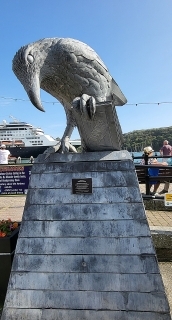
In the centre of Fowey, on the waterfront, there is a modern sculpture of a bird holding a book with one of its claws. Called “The Rook with a Book”, it was created by the Thrussels, a father and son team of sculptors based in Bodmin Moor at a point near to the source of the River Fowey. The sculpture was unveiled in 2018 by Daphne’s son Christian. The book being held by the rook bears the title of one of Daphne’s short stories – “The Birds”, published in 1952. The story was inspired by seeing a flock of gulls attacking a farmer working on a field. It was set in Cornwall soon after WW2. What makes this short story particularly significant is that it inspired Alfred Hitchcock to create his horror film “The Birds”, which was first released in March 1963.
September 29, 2023
A grave anagram in a church in Cornwall
ON OUR WAY TO LOOE (in Cornwall), where we hoped to buy fresh fish – and we did – we passed through an extraordinarily picturesque village called Lerryn, which lies on the banks of the River Lerryn (a tributary of the River Fowey). The shopkeeper in the village store recommended that we took a look at the church in nearby St Winnow (aka ‘St Winnoc’). On our way to this place, which is at the very end of a narrow country lane, we were first slowed down by a flock of pheasants which refused to get off the road, and then by some workers felling a tree.
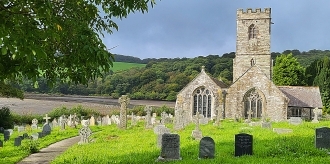
The parish church of St Winnow was built mainly in the 15th century and is positioned on a slope overlooking a stretch of the River Fowey. It is named after a saint, who is new to me. According to a website (www.anglozuluwar.com/images/Journal_10/St_Winnow_Church.pdf):
“St Winnow was one of the tireless band of Celtic priests and evangelists who consolidated and extended the Christian Church in Wales, Ireland, Cornwall and Brittany after the withdrawal of the Roman legions in the 5th Century. St Winnoc probably grew up in Wales and came here in about 670 AD to begin his missionary work, forming a small religious community and establishing a Lan or sacred enclosure. Eventually he moved to Northern France and founded a monastery at Wormhout, not far from Dunkirk.”
The church contains pews with beautifully carved endings. Two of its east windows have stained glass that dates from 1500. One of these windows contains a good display of the types of clothing worn at that time. The carved granite font, created in the 15th century, has bas-reliefs depicting angels with outstretched arms. All these features and others including the gothic architectural style make the church worth seeing. However, one thing struck me as being particularly unusual. It is an inscribed slate memorial on the north wall of the Lady Chapel.
The slate commemorated the death of William Sawle, who was buried on the 16th of February 1651. Beneath his name there is an anagram of it, which reads:
“I was ill: am wel”
‘Wel’ being a variation of the spelling of ‘well’.
Below this, there is the following verse:
“When I WAS sick, most men did deeme me ILL
If I had liv’d, I should have beene soe still.
Prais’d be the Lord, that in the Heav’ns doth dwell
Who hath received my Soule. Now I AM WEL.”
And beneath this, there is information, carved on the slate, that informs the viewer that Sir JSG Sawle Penrice repaired it “… out of respect to his Maternal Ancestors …” in 1838.
The Sawle family have lived in Cornwall since the time of William the Conqueror. By 1620, they were living at Penrice House near St Austell (see: http://www.sole.org.uk/sole2/penrice.htm). As for William Sawle, whose memorial bears an anagram, I cannot tell you anything yet because I have not found any information about him. However, his memorial in St Winnow is a great example of grave humour.



